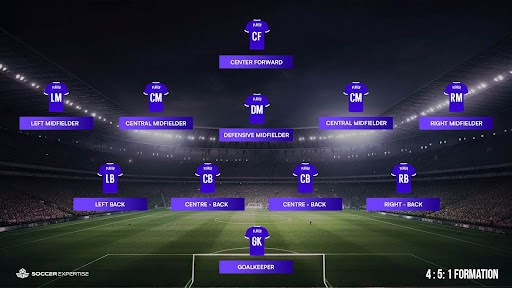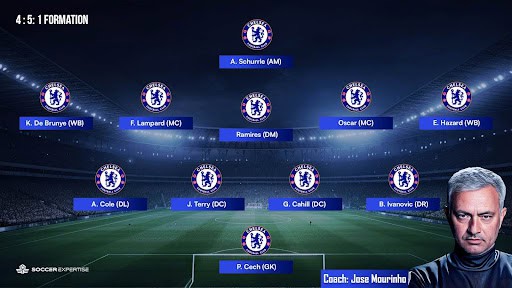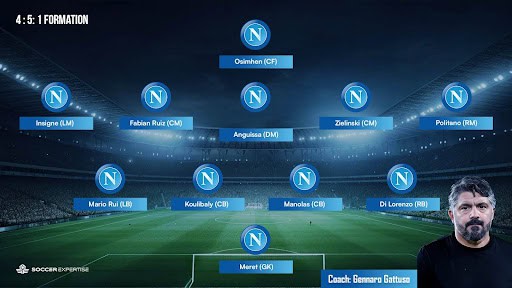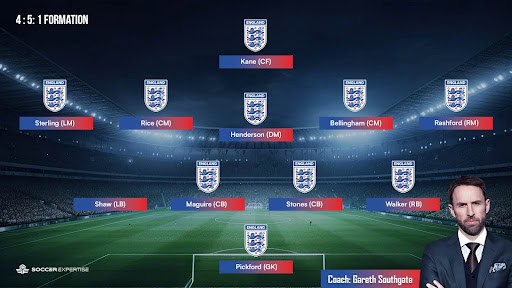As someone who played soccer quite well in his early formative years, formations were not a thing at the grassroots. My peers and I just knew how to play soccer and get on the pitch to enjoy ourselves. Soccer fuels our direction.
With more education about soccer and growth, I learned about formations – a direction a coach wants his team to set up before a match.
It is important to go into a game with a formation or multiples because it helps to monitor player movements and contributions in games.
In this particular piece, I will share some knowledge about the pros and cons of playing a 4-5-1 formation and cite some examples to aid the learning process.
No knowledge about soccer can be a waste, so let’s journey together.
What is a 4-5-1 Formation in Soccer?

The 4-5-1 formation is simple to define as it has a backline of four defenders – two center backs, one right back, and one left back.
In midfield, there are five players with various responsibilities—three central midfielders and two wide players (right and left-wing).
At the top of the formation is a lone center-forward. It can be the perfect formation for counter-attacking football, instilling a defensive mindset in any team.
How Do You Play a 4-5-1 in Soccer?
The 4-5-1 is one of the most popular formations in soccer. Although it has various variations of it, one constant thing is the number of defenders – four – remains that.
In midfield, different responsibilities might be given to the players deployed, while there is usually a lone center forward at the top of the attack.
Being flexible and easy to adapt, the 4-5-1 is quite popular among a lot of teams and it is particularly easier to abandon and switch during games to other formations.
With that in mind, let’s take a look at some of its variations with the following;
FLAT 4-5-1
In a flat 4-5-1 – as the name implies – this has to do with the midfield, which is where a lot of the variations happen.
The five picked to play in the midfield nearly form a straight line and are saddled with the responsibility of stopping every opportunity to pass the opposition has to play their forwards in behind.
The major benefit of this formation is that it is quite effective while defending, and as soon as there is a turnover, it is easier for the team to form attacking triangles to pass their way out into the final third or break in numbers to hurt the opposition.
This aids the counter-attacking style as it helps at least two or three midfielders start the press or the two wide players or both.
It also aids defense support, as some of the players not active during the pressing, can hold their position and keep the team in shape.
One major disadvantage of a flat 4-5-1 is that the striker, who is stationed at the top of the attack, can be isolated a lot.
However, if properly utilized or executed, it is a formation that can be easily adjusted into a 4-3-3 or 4-2-3-1 in attack.
4-2-3-1
The 4-2-3-1 is quite a popular formation in soccer and around the world. It has gained prominence within the last few years amid the slow decline of the 4-4-2.
As explained earlier, variations with the 4-5-1 happen in the midfield. In the case of the 4-2-3-1, there is an extra midfielder who acts as a playmaker in front of a strong defensive-mid base.
Just like the other variations of 4-5-1, this formation can easily be changed into a 4-3-3 – the playmaker falls deep, and wingers play higher and wider while being able to also change into a defensive 4-5-1 if the wingers play low.
It is a type of formation Jose Mourinho has utilized for much of his career as it is not only perfect counter-attacking football, but it allows for lightning-quick transitions in attack.
The major problem with the 4-2-3-1 formation is that the attacking midfielder must be the focal point in attack.
If the attacking midfielder goes missing or he is marked out e.g Mesut Ozil or Bruno Fernandes, the formation is no longer effective.
You can read extensively on the 4-2-3-1 formation in our detailed piece on the setup (a backlink can be done here).
4-4-1-1
This formation is former Burnley manager Sean Dyche’s favorite formation. The 4-4-1-1 has a defensive overtone without any doubt.
With the presence of the flat back four, it has a lot of defensive cover for shutting down passing lanes.
The 4-4-1-1 suits a rugged style of play, and because teams with low quality rely on it a lot, it can get the best out of players who lack a natural talent on the ball.
In simple terms, it is an option for teams that do not keep a large amount of ball possession.
While it is a solid strategy to bring the striker, wingers, and attacking midfielder, into the game when needed, it lacks the extra central midfielder that the 4-5-1 can provide.
Since it is popular among teams that struggle in possession anyway, that extra central midfielder may become useless.
Burnley and Atletico Madrid used this formation to a great length, while France’s 2018 World Cup-winning squad also utilized it to great effect.
What is the Best Formation to Use Against 4-5-1?
In terms of shape, the 4-3-3 formation remains the best formation to counter the 4-5-1 formation.
A lone defensive pivot with two dynamic No. 8s in front will keep the midfield of the opposition occupied while both full-backs bump forward, provide width, and nullify the strength of the 4-5-1 formation in wide areas.
The application of this formation is quite crucial as it relies heavily on the capacity of the full-backs and the attacking midfielders to do their jobs. However, if well executed, it can work.
The Strengths of the 4-5-1 Formation
The 4-5-1 formation focuses on wide play and it helps the midfield to span the entire width of the pitch.
The play can be built across the pitch with quick speed to catch the opponents off guard.
Although the 4-5-1 formation is primarily for promoting possession football (which is what formations like 4-2-3-1 often end up doing), it contains multiple routes of attack.
The formation helps teams work the ball into wide areas and spam crosses into the box.
They can also go directly, bypassing the opposition midfield and getting the ball forward quickly to their lone striker.
What Are the Weaknesses of the 4-5-1 Formation?
Having learned about the pros of the 4-5-1 formation in soccer, can we take a look at some shortcomings of this popular formation?
We start with the range of attacking responsibilities placed on the ‘1’ in a 4-5-1 system: the lone striker.
The striker has a lot of pressure on his back, as his goalscoring ability is not the only thing needed. The striker has to lead the press, often alone.
If he gets lucky to win possession in a vantage position, he might be lacking the necessary support, so the striker in question has to be good at holding up and keeping the ball until teammates arrive.
While the striker could be left isolated up front, the wide midfielders or wingers in the 4-5-1 system are expected to provide support high up the pitch.
However, during the course of providing support in attack, they might forget their defensive duties and the opposition can exploit those gaps left behind to punish them.
The bulk of the work is on the qualities of the midfielders. They must have decent passing skills, be physically strong, and possess solid defensive awareness – failure to tick all those boxes and many more could lead to a breakdown in the system.
Which Clubs and Managers Have Used the 4-5-1 Formation Successfully?
The 4-5-1 formation in soccer is quite popular, and having learned about its pros and cons, it will be important to cite examples of teams or coaches who have successfully thrived using this formation and its variation.
Jose Mourinho, Chelsea

This formation gained popularity with Jose Mourinho. He has been a firm believer in the formation since his breakthrough with Porto.
The Special One has used the formation almost throughout his career, and it is out of place not to reference his team first.
Jose Mourinho’s Chelsea team, in his first stint back in the mid-2000s, employed the 4-5-1 system to great effect.
During the 2004/05 season, they won the Premier League, conceding just 15 goals during the campaign – a PL record that still stands today.
In Mourinho’s team, French legend Claude Makelele is positioned at the base of the midfield – a lone pivot who is to protect the backline and allow box-to-box midfielders like Frank Lampard to go forward, support attacks in quick time, and work the ball wide into good crossing positions.
In addition, wingers like Damien Duff, Arjen Robben, and Joe Cole break on the counter with Didier Drogba waiting for the balls in the box.
Carlo Ancelotti, Bayern Munich
The legendary Ancelotti is another manager who utilizes wing play effectively while managing the German giants Bayern Munich.
With the quality of Arjen Robben and Franck Ribery in wide areas, the 4-5-1 formation was constantly used. In its application, Ancelotti’s system depends deeply on wingers crossing balls with sharp precision.
As a sign of extreme application, Carlo Ancelotti’s side won the 2016-17 Bundesliga campaign, and 12 goals were scored from crosses – the most in the division.
Napoli 2019-2021 with Gennaro Gattuso

Under Gennaro Gattuso’s guidance, Napoli won the 2020 Coppa Italia. The Italian side used a disciplined 4-5-1 mid-block to great effect in the UEFA Champions League and Serie A.
In its application, the striker – usually Dries Mertens or Arkadiusz Milik – has a responsibility to drop and receive the ball back to goal, while the wide midfielders/wingers – Lorenzo Insigne and José Callejón – move forward with the ball. In addition, the front three was particularly fluid.
Meanwhile, when Napoli were out of possession, they usually showed great defensive flexibility. In most cases, Napoli employed a low block according to threats posed by the opposition while maintaining their compactness in the central spaces.
England under Gareth Southgate

Although he has moved to a back-three system in recent times, Gareth Southgate is another manager on the international scene who has used the 4-5-1 formation to achieve something.
The England head coach has favored a mid-block without the ball, utilizing either a 4-1-4-1 or the flat 4-5-1 variation of the formation.
In this system, Declan Rice plays as the pivot but also has the liberty to take up positions high up the pitch while the number eight gets closer to Harry Kane, who is at the top of the formation.
With the quality of Jude Bellingham, Bukayo Saka, and Jack Grealish on the wings, the Three Lions work the ball into the wide areas while the midfielders maintain their defensive positions and act as cover for the players high up the pitch.
Final Thoughts
We have been able to learn about the 4-5-1 formation in soccer. In addition, we have seen the variations, pros, and cons of the formation.
The 4-5-1 formation looks like one that will remain in soccer for a while because of its flexibility. So, a lot of clubs might be setting up with the 4-5-1, but the application can be slightly different.

